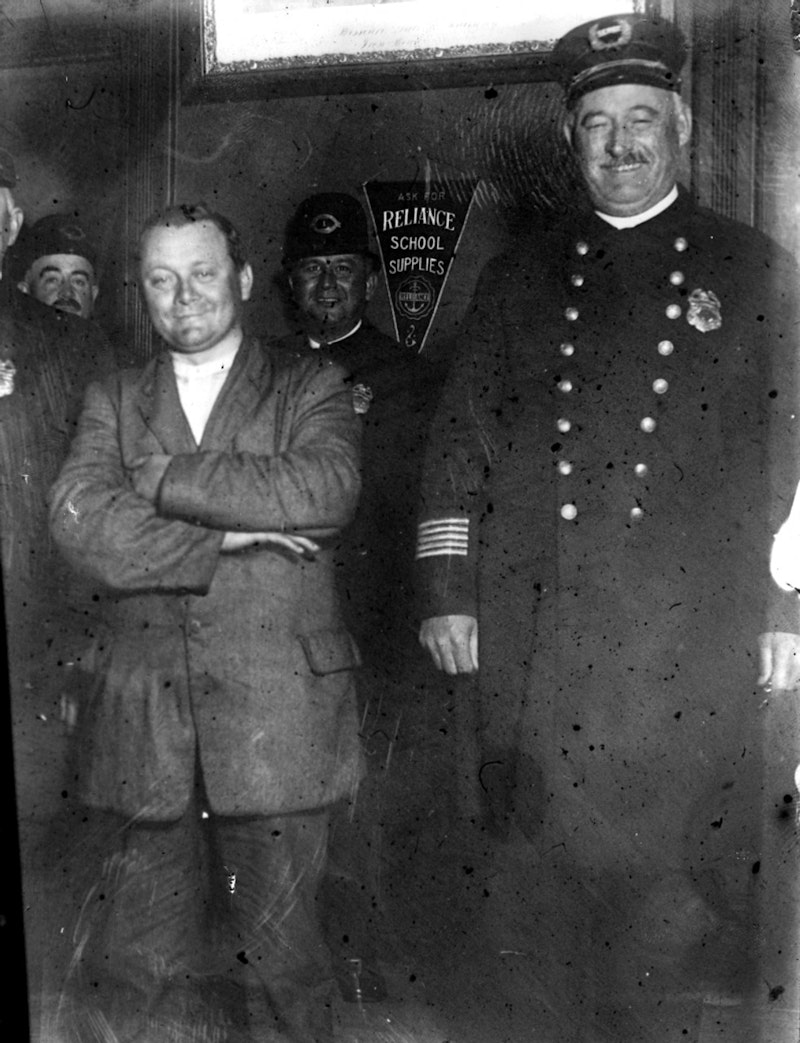On the evening of October 14, 1912, Theodore Roosevelt prepared to give a speech in Milwaukee. He was trying to regain the presidency as a candidate for the newly-formed Bull Moose Party. Exhausted from the long and brutal campaign, his voice was nearly gone. Against the advice of his doctor, he insisted on keeping a promise to speak to the voters of Wisconsin. He attended a banquet in his honor at the Gilpatrick Hotel and then waited for a car to drive him to the auditorium where he’d speak.
Thousands of supporters cheered his name as he approached the car. At that moment, a saloonkeeper named John Schrank approached Roosevelt and aimed a large pistol from point-blank range. The gun fired and a .32-caliber bullet hit the right side of Roosevelt’s chest. Roosevelt collapsed into the car. As Schrank prepared to take a second shot, Roosevelt’s stenographer Elbert Martin, a former football player, tackled the shooter and began to strangle him. “I wasn’t trying to take him prisoner,” Martin later said. “I was trying to kill him.”
Despite his wound, Roosevelt rose to his feet and yelled, “Bring him here. Don’t hurt him.” He stared directly into his would-be assassin’s eyes and asked why he did it. Schrank said nothing. Police arrested the man and Roosevelt collapsed. He urged the chauffeur to drive straight to the auditorium, not the hospital. Though he felt a “knifelike pain in his ribs,” Roosevelt wasn’t spitting up blood. He knew this meant the bullet hadn’t reached his lungs.
At the auditorium, a doctor examined Roosevelt. He noticed a wound under Roosevelt’s right nipple and a bloodstain on his shirt “the size of a man’s hand.” The doctor applied a bandage to Roosevelt’s chest. Roosevelt told the shocked crowd, “It takes more than one bullet to kill a Bull Moose.” He then reached into his jacket and removed his steel eyeglass-case and 50-page typewritten speech. He noticed a hole in the pages and a dent in the case. If the bullet hadn’t been deflected upwards, it would’ve gone straight into his heart.
Roosevelt spoke for an hour and then was driven to the hospital. The bullet fractured Roosevelt’s fourth rib on the right. Roosevelt knew he was lucky to be alive. This was déjà vu for Roosevelt. In 1901, an anarchist assassinated President William McKinley in Buffalo. This elevated Vice-President Roosevelt to the presidency. He was re-elected in 1904 then opted to forgo a third term despite his immense popularity. Roosevelt helped his close friend and former cabinet member William Howard Taft win the 1908 election. Roosevelt subsequently grew displeased with Taft’s agenda believing his former protégé was dismantling Roosevelt’s Progressive legacy.
Roosevelt declared his candidacy for the 1912 election hoping to unseat Taft. Taft defeated Roosevelt in the Republican primary. Undaunted, Roosevelt formed the Bull Moose Party dedicated to Progressive causes. On the day he was shot, the election was just three weeks away. While Roosevelt recovered at the hospital, police interviewed John Schrank who said he’d had a dream where President McKinley rose from his coffin and accused Roosevelt as his murderer. Casting himself as an avenging angel, Schrank followed Roosevelt on the campaign trail waiting for a chance to shoot him. His opportunity came in Milwaukee.
Doctors decided against removing the bullet due to its proximity to Roosevelt’s lungs. Roosevelt told reporters, “There are only three possible dangers: pleurisy, pneumonia and blood poisoning.” After a week, Roosevelt’s vitality returned. His wound remained open but he returned to the campaign trail. He would carry the bullet inside him the rest of his life.
Prior to the shooting, Roosevelt’s election prospects were grim. The attack renewed support for the ex-President. Roosevelt spoke to 16,000 supporters at Madison Square Garden three days before the election. Democrat Woodrow Wilson won the presidency despite Roosevelt’s best efforts.
After the election, Roosevelt went on an expedition to the River of Doubt in the Amazon jungle. He suffered a leg wound while trying to prevent his canoe from slamming into the rocks. The wound became infected and morphed into malaria. He developed a 103-degree fever and suffered chest pains made worse by the bullet lodged inside him. Because of the severe agony, he planned to commit suicide by overdosing on morphine. Only the intervention of his son Kermit kept him alive.
Roosevelt survived his Amazon adventure despite losing more than 50 pounds. For the rest of his life he suffered from flareups of malaria and leg inflammation. He died of a coronary embolism in 1919 at the age of 60.
John Schrank was committed to the State Hospital for the Criminally Insane in Wisconsin. He remained there until his death of bronchial pneumonia in 1943.

